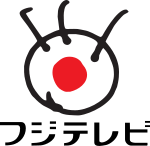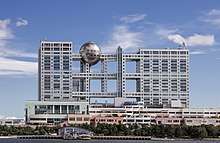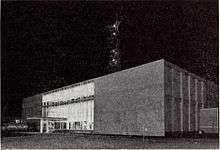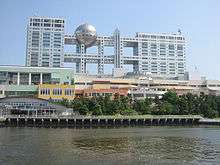Fuji TV
JOCX-DTV, branded as Fuji TV (フジテレビ, Fuji Terebi) and colloquially known as CX, is a Japanese television station based in Odaiba, Minato, Tokyo, Japan. Owned and operated by the Fuji Television Network, Inc.,[lower-alpha 2] it is the flagship station of the Fuji News Network (FNN) and the Fuji Network System. It is also known for its long-time slogan, "If it's not fun, it's not TV!"[lower-alpha 1]
 | |
 Headquarters of Fuji Media Holdings and Fuji TV in Odaiba | |
Native name | 株式会社フジ・メディア・ホールディングス |
|---|---|
| Public KK | |
| Traded as | TYO: 4676 |
| Industry | Information, Communication |
| Founded | November 18, 1957, (Fuji Television Network, Inc.) |
| Headquarters | 4-8, Daiba Nichome, Minato, Tokyo, Japan |
Area served | Japan |
Key people | Masaki Miyauchi (Chairman and CEO) Osamu Kanemitsu (President and COO) |
| Services | Broadcasting holdings |
| ¥22,319 million (consolidated, March 2017) [1] | |
| ¥27,396 million (consolidated, March 2017) [1] | |
| Total assets | ¥1,018.5199 billion (consolidated, March 2017) [1] |
| Parent | Toho (7.86%), Nippon Cultural Broadcasting (3.30%; ultimately owned by the Society of Saint Paul) |
| Subsidiaries | Fuji Television Network, Inc. Nippon Broadcasting System Pony Canyon Fujisankei Communications International Fusosha Publishing Sankei Shimbun Co., Ltd. (39%) |
| Website | www |
 | |
Native name | 株式会社フジテレビジョン |
|---|---|
| Kabushiki gaisha | |
| Industry | Information, Communication, Mass media |
| Founded | October 1, 2008, (to take over the broadcasting business of former Fuji TV (renamed "Fuji Media Holdings, Inc.")) |
| Headquarters | 4-8, Daiba Nichome, Minato, Tokyo, Japan |
Key people | Masaki Miyauchi (Chairman and CEO) Ryunosuke Endo (President and COO) |
| Services | Telebroadcasting |
| Parent | Fuji Media Holdings |
| Subsidiaries | David Production |
| Website | www |
 | |
| Kantō Region, Japan | |
|---|---|
| City | Tokyo |
| Channels | Digital: 21 (UHF - LCN 8) |
| Branding | Fuji Television |
| Slogan | If it's not fun, it's not TV![lower-alpha 1] |
| Programming | |
| Affiliations | Fuji News Network |
| Ownership | |
| Owner | Fuji Television Network, Inc. |
| Sister stations | BS Fuji Fuji TV One Fuji TV Two Fuji TV Next |
| History | |
| Founded | November 18, 1948 |
| First air date | (analog) March 1, 1959 (digital) December 1, 2003 |
| Last air date | (analog) July 24, 2011 |
| Former channel number(s) | Analog: 8 (VHF) (1959-2011) |
| Technical information | |
| ERP | 10 kW (68 kW ERP) |
| Transmitter coordinates | 35°39′31″N 139°44′44″E |
| Translator(s) | Hachiōji, Tokyo Analog: Channel 31 Tama, Tokyo Analog: Channel 58 |
| Links | |
| Website | www |
Fuji Television also operates three premium television stations, known as "Fuji TV One" ("Fuji TV 739"—sports/variety), "Fuji TV Two" ("Fuji TV 721"—drama/anime), and "Fuji TV Next" ("Fuji TV CSHD"—live premium shows) (called together as "Fuji TV OneTwoNext"), all available in high-definition.
Fuji Television is owned by Fuji Media Holdings, Inc.[lower-alpha 3], a certified broadcasting holding company under the Japanese Broadcasting Act, and affiliated with the Fujisankei Communications Group. The current Fuji Television was established in 2008. Fuji Media Holdings is the former Fuji Television founded in 1957.
Offices
The headquarters are located at 2-4-8, Daiba, Minato, Tokyo.[2] The Kansai office is found at Aqua Dojima East, Dojima, Kita-ku, Osaka. The Nagoya office is found at Telepia, Higashi-sakura, Higashi-ku, Nagoya. The Japanese television station also has 12 bureau offices in other parts of the world in locations in countries such as, France, Germany, Russia, USA, South Korea, China, Italy, Thailand and the UK.[3]
History of Fuji TV
Fuji Television Network Inc. was founded in 1957 by Nobutaka Shikanai and Shigeo Mizuno, presidents of Nippon Broadcasting System and Nippon Cultural Broadcasting respectively.[4] It started broadcasting on March 1959.[5] In June of that year, Fuji TV formed a network with Tokai TV, Kansai TV, and KBC Television. In October 1966, a news network of exchanging news with local stations with the name of FNN (Fuji News Network) was formed.
On April 1, 1986, Fuji TV changed their corporate logo from the old "Channel 8" logo, to the "Medama" logo used by the Fujisankei Communications Group. In 1986 and 1987, Fuji TV worked with Nintendo to create two games called All Night Nippon Super Mario Bros. and Yume Kojo: Doki Doki Panic for the Famicom. All Night Nippon Super Mario Bros. was a retooled version of Super Mario Bros. with some minor changes, such as normal levels being replaced with levels from Super Mario Bros.: The Lost Levels and some enemies being replaced with Japanese celebrities with comedic effect. Yume Kojo: Doki Doki Panic later became the basis for Super Mario Bros. 2, which was subsequently released a year later.
In October 1987, Fuji TV began branding their late-night/early-morning slots collectively as JOCX-TV2 (meaning "alternative JOCX-TV") in an effort to market the traditionally unprofitable time slots and give opportunities to young creators to express their new ideas. JOCX-TV2 featured numerous experimental programs on low budgets under this and follow-on brands, a notable example being Zuiikin' English which first aired in spring 1992. The JOCX-TV2 branding itself was changed in October 1988 to JOCX-TV+, which lasted until September 1991, when it was replaced with GARDEN/JOCX-MIDNIGHT in October 1991. Meanwhile, Fuji TV helped produced only the third series of the British children's television programme Thomas the Tank Engine & Friends (now called Thomas & Friends) with its creator and producer Britt Allcroft. The GARDEN/JOCX-MIDNIGHT branding lasted until September 1992 when it was replaced with the JUNGLE branding, which lasted from October 1992 to September 1993. The JOCX-MIDNIGHT branding was introduced in October 1993 to replace the previous JUNGLE branding, and lasted until March 1996 when Fuji TV decided to stop branding their late-night/early-morning slots.
On March 10, 1997, Fuji TV moved from their old headquarters in Kawadacho, Shinjuku, into a new building in Odaiba, Minato designed by Kenzo Tange.
Since 2002, Fuji TV has co-sponsored the Clarion Girl contest, held annually to select a representative for Clarion who will represent Clarion's car audio products in television and print advertising campaigns during the following year.
On April 1, 2006, Fuji TV split up the radio broadcasting and station license of Nippon Broadcasting System into a newly established company with the same name. The remaining of the old Nippon Broadcasting System was dissolved into Fuji TV. This resulted in the assets of Nippon Broadcasting System being transferred over to Fuji TV.[6]
On October 1, 2008, Fuji TV became a certified broadcasting holding company "Fuji Media Holdings, Inc." (株式会社フジ・メディア・ホールディングス, Kabushiki gaisha Fuji Media Hōrudingusu) and newly founded "Fuji Television Network Inc." took over the broadcasting business.[7]
Fuji TV, which broadcasts Formula One in Japan since 1987, is the only media sponsor of a Formula One Grand Prix in the world. Fuji TV has also licensed numerous Formula One video games including Human Grand Prix IV: F1 Dream Battle.
TV broadcasting
Analog
- as of July 24, 2011, end date
JOCX-TV - Fuji Television Analog (フジテレビジョン・アナログ)
- Tokyo Tower - Channel 8
Digital
JOCX-DTV - Fuji Digital Television (フジデジタルテレビジョン)
- Remote controller button 8
- Tokyo Skytree - Channel 21
Branch stations
- Tokyo bottom
- Hachioji (analog) - Channel 31
- Tama (analog) - Channel 55
- Islands in Tokyo
- Chichijima (analog) - Channel 57
- Hahajima (analog) - Channel 58
- Niijima (analog) - Channel 58
- Ibaraki Prefecture
- Mito (analog) - Channel 38
- Mito (digital) - Channel 19
- Hitachi (analog) - Channel 58
- Hitachi (digital) - Channel 19
- Tochigi Prefecture
- Utsunomiya (analog) - Channel 57
- Utsunomiya (digital) - Channel 35
- Gunma Prefecture
- Maebashi (analog) - Channel 58
- Maebashi (digital) - Channel 42
- Saitama Prefecture
- Chichibu (analog) - Channel 29
- Chichibu (digital) - Channel 21
- Chiba Prefecture
- Narita (analog) - Channel 57
- Tateyama (analog) - Channel 58
- Choshi (analog) - Channel 57
- Choshi (digital) - Channel 21
- Kanagawa Prefecture
- Yokosuka-Kurihama (analog) - Channel 37
- Hiratsuka (analog) - Channel 39
- Hiratsuka (digital) - Channel 21
- Odawara (analog) - Channel 58
- Odawara (digital) - Channel 21
- Okinawa Prefecture
- Kita-Daito (analog) - Channel 46
- Minami-Daito (analog) - Channel 58
Overseas
- U.S. (leased access, selected programs)
- San Francisco, California KTSF - Channel 26
- New York WMBC-TV - Channel 63
- Honolulu, Hawaii - Nippon Golden Network
Networks
.png)


- Headquartered in Osaka, broadcast in the Kansai area: Kansai TV, Analog Channel 8, Digital Channel 17 [ID: 8]
- Headquartered in Nagoya, broadcast in the Chukyo area: Tokai TV, Analog Channel 1, Digital Channel 21 [ID: 1]
- Headquartered in Sapporo, broadcast in Hokkaidō: Hokkaido Cultural Broadcasting, Analog Channel 27, Digital Channel 25 [ID: 8]
- Headquartered in Nagano, broadcast in Nagano Prefecture: Nagano Broadcasting Systems, Analog Channel 38, Digital Channel 15 [ID: 8]
- Headquartered in Fukuoka, broadcast in Fukuoka Prefecture: Television Nishinippon Corporation, Analog Channel 9, Digital Channel 34 [ID: 8]
- Headquartered in Naha, broadcast in Okinawa Prefecture: Okinawa Television, Analog Channel 8, Digital Channel 15 [ID: 8]
Programming
Tokusatsu
- Mirrorman (1971–1972)
- Toei Fushigi Comedy Series (1981–1993)
- Megaloman (1979)
- Robot Detective K (1973)
Dramas
Japanese
- Long Vacation (ロングバケーション) (1996)
- Furuhata Ninzaburō (古畑任三郎)
- Bayside Shakedown (踊る大捜査線) (1997)
- With Love (1999)
- Hero (2001)
- Shiroi Kyotō (白い巨塔) (2003–2004)
- Water Boys (ウォーターボーイズ) (2003, 2004)
- Dr.Coto Shinryojo (Dr.コトー診療所) (2003, 2004)
- Densha Otoko (電車男) (2005)
- Umizaru Evolution (海猿) (2005)
- Oniyome Nikki (鬼嫁日記) (2005)
- 1 Litre of Tears (1リットルの涙) (2005, Tuesday 9:00 PM)
- Attention Please (アテンションプリーズ) (2006, Tuesday 9:00 PM)
- Kekkon Dekinai Otoko (結婚できない男) (2006)
- Nodame Cantabile (のだめカンタービレ) (2006)
- Proposal Daisakusen (プロポーズ大作戦) (2007, Monday 9:00 PM)
- Life (ライフ) (2007)
- Hanazakari no Kimitachi e Ikemen Paradise (花ざかりの君たちへ イケメン♂パラダイス) (2007)
- Galileo (ガリレオ) (2007, Monday 9:00 PM)
- Zettai Kareshi (2008)
- Fantastic Deer-man (鹿男あをによし, Shikaotoko Aoniyoshi) (2008)
- Last Friends (ラスト・フレンズ) (2008, Thursday 9:00 PM)
- Bara no nai Hanaya (薔薇のない花屋) (Winter 2008, Monday 9:00 PM)
- Change (チェンジ) (Spring 2008, Monday 9:00 PM)
- Homeroom on the Beachside (太陽と海の教室) (Summer 2008, Monday 9:00 PM)
- Innocent Love (イノセント・ラヴ) (Autumn 2008, Monday 9:00 PM)
- BOSS (2009, Thursday 9:00 PM)
- Voice (ヴォイス) (Winter 2009, Monday 9:00 PM)
- Konkatsu! (婚カツ!) (Spring 2009, Monday 9:00 PM)
- Buzzer Beat (Summer 2009, Monday 9:00 PM)
- Tokyo Dogs (東京DOGS) (Autumn 2009, Monday 9:00 PM)
- Priceless (あるわけねぇだろ,んなもん!) (Autumn 2012, Monday 9:00 PM)
- Biblia Koshodō no Jiken Techō (ビブリア古書堂の事件手帖) (Winter 2013, Monday 9:00 PM)
- Galileo 2 (ガリレオ) (Spring 2013, Monday 9:00 PM)
- Summer Nude (サマーヌード) (Summer 2013, Monday 9:00 PM)
- Fight! Bookstore Girl (戦う!書店ガール, Spring 2015)
- Good Morning Call (autumn 2016) on Netflix and Fuji TV
Korean
Since 2010, Fuji TV started airing Korean dramas on its Hanryū Alpha (韓流α, Hanryū Arufa, "Korean Wave Alpha") block programming.[8] Its current time slot since March 2012 is 14:07 - 16:53 JST (2:07 - 4:53 PM), Mondays to Wednesdays; and 15:07 - 16:53 JST (3:07 - 4:53 PM), Thursdays to Fridays.
Cookery
- Iron Chef (1993–1999, 2001 Special)
News and information
- Mezamashi TV (めざましテレビ, April 1994 - present) - Morning news program.
- FNN TV Morning Edition (FNNテレビ朝刊, October 1966 - September 1975) - Morning news program.
- FNN News 7:30 (FNNニュース7:30, October 1975 - March 1977) - Morning news program.
- FNN TV Morning Edition (FNNテレビ朝刊, April 1977 - March 1982) - Morning news program.
- FNN Morning Wide: News & Sports (FNNモーニングワイド ニュース&スポーツ, April 1982 - March 1986) - Morning news program.
- FNN Morning Call (FNNモーニングコール, April 1986 - March 1990) - Morning news program.
- FNN Morning First Run! (FNN朝駆け第一報!, April 1990 - March 1991) - Morning news program.
- FNN World Uplink (April 1991 - March 1993) - Morning news program.
- FNN Good Morning! Sunrise (FNN おはよう!サンライズ, April 1993 - March 1994) - Morning news program.
- Tokudane! (情報プレゼンター とくダネ!, April 1999 - present) - Morning news program.
- Hiroshi Ogawa's Show (小川宏ショー, May 1965 - March 1982) - Morning news program.
- Good Morning! Nice Day (おはよう!ナイスデイ, April 1982 - March 1994) - Morning news program.
- Nice Day (ナイスデイ, April 1994 - March 1999) - Morning news program.
- Live News days (April 2019 – present) - News program before noon.
- Sankei Telenews FNN (FNNニュースレポート11:30, October 1966 - March 1982) - News program before noon.
- FNN News 12:00 (FNNニュース12:00, October 1975 - March 1977) - News program before noon.
- Sankei Telenews FNN (FNNニュースレポート11:30, April 1977 - March 1982) - News program before noon.
- FNN News Report 11:30 (FNNニュースレポート11:30, April 1982 - September 1987) - News program before noon.
- FNN Speak (FNNスピーク, October 1987 - March 2018) - News program before noon.
- Prime News Days (April 2018 - March 2019) - News program before noon.
- Live News it! (April 2019 – present) - Evening news program.
- FNN News (FNNニュース, October 1966 - October 1970) - Evening news program.
- FNN News 6:30 (FNNニュース6:30, October 1970 - September 1978) - Evening news program.
- FNN News Report 6:00/6:30 (ニュースレポート6:00/6:30, October 1978 - March 1984) - Evening news program.
- FNN Super Time (FNN, FNNスーパータイム, October 1984 - March 1997) - Evening news program.
- FNN News555 The human (FNNニュース555 ザ・ヒューマン, April 1997 - March 1998) - Evening news program.
- FNN Supernews (FNNスーパーニュース, April 1998 - March 2015) - Evening news program.
- Minna No News (みんなのニュース, April 2015 - March 2018) - Evening news program.
- Prime News Evening (プライムニュース イブニング, April 2018 - March 2019) - Evening news program.
- Live News α (April 2019 – present) - Night news program.
- News Talk (ニュース対談, March 1959 - September 1965) - Night news program.
- Today's News (きょうのニュース, October 1965 - March 1966) - Night news program.
- This is News (こちら報道部, April 1966 - March 1968) - Night news program.
- FNN News Final Edition (FNNニュース最終版, April 1968 - March 1977) - Night news program.
- FNN News Report 23:00 (FNNニュースレポート23:00, April 1977 - March 1987) - Night news program.
- FNN News Factory (FNNニュース工場, April - September 1987) - Night news program.
- FNN Date Line (October 1987 - March 1990) - Night news program.
- FNN Newscom (April 1990 - March 1994) - Night news program.
- News Japan (ニュースJAPAN, April 1994 - March 2015) - Night news program.
- Ashita No News (あしたのニュース, April 2015 - March 2016) - Night news program.
- You're Time 〜Anata No Jikan〜 (ユアタイム〜あなたの時間〜, April 2016 - September 2017) - Night news program.
- The News α (October 2017 - March 2018) - Night news program.
- Prime News α (April 2018 - March 2019) - Night news program.
- Kids News - Weekly children's news program
Sport
- Sport (すぽると!)
- Baseball Special Yakyudo (BASEBALL SPECIAL ~野球道~, Baseball games of the Yomiuri Giants and the Tokyo Yakult Swallows)
- Swallows Baseball Live (Baseball games of the Tokyo Yakult Swallows, satellite TV (SKY PerfecTV!) Fuji TV One)
- Formula One World Championship (1987–present, FNS (Sunday) and satellite TV (SKY PerfecTV!) Fuji TV Next (live), Fuji TV Two (F1 Monday))
- Main sponsor of "Formula One Fuji TV Japanese Grand Prix" from 1987 until 2009
- Men's World Cup, Women's World Cup, World Grand Prix
- Horse Racing Live (みんなのケイバ)
- K-1 kickboxing events
- Pride Fighting Championships (Mixed Martial Arts from the Pride organization. Contract ended on June 5, 2006)
- World Judo Championships
- International Chiba Ekiden
- World Figure Skating Championships (since 2003–2004 season)
- Japan Figure Skating Championships (since 2003–2004 season)
- Fujisankei Classic
- Rizin Fighting Federation
- World Victory Road (Mixed Martial Arts)[9]
Variety shows
- IQ Sapuri (脳内エステ IQサプリ) - end
- Toribia no Izumi (トリビアの泉) (Spike TV produced an American version of Hey! Spring of Trivia.)
- The Gaman
- Flyer TV
- Zuiikin' English
- Mecha-Mecha Iketeru!
- Waratte Iitomo! (森田一義アワー 笑っていいとも!) (October 1982 - March 2014)
- Hey! Hey! Hey! Music Champ (October 1994 - December 2012)
- Domoto Kuyodai (ended)
- Music Fair
- FNS Music Festival
- Idoling!!!
- a-nation 2012[10]
- Johnny's Countdown Live (ジャニーズカウントダウンライブ) (December 31, 1996 -)
Reality television
- Ainori (あいのり, October 11, 1999–March 23, 2009) – Dating program that takes place on a pink van traveling the world.
- VivaVivaV6 (April 2001–present)
- Magic Revolution (2004–present)
- Game Center CX (2003–present)
Game shows
- Brain Wall (Hole in the Wall in United States)
- Quiz $ Millionaire (Japanese version of Who Wants to be a Millionaire?; April 2000-March 2007, New Year's Special 2013)
- Vs. Arashi (April 2008–present)
- The Weakest Link (April–September 2002)
- Bruce Forsyth's Play Your Cards Right (1980-2003)
- Minute to Win It (2013)
See also
- Fujisankei Communications Group
- Television in Japan
- Hobankyo – Organization based in Japan that enforces Fuji Television copyright issues.
References
- Tanoshi-ku na kereba terebi ja nai! (楽しくなければテレビじゃない!)
- Japanese: 株式会社フジテレビジョン Hepburn: Kabushiki gaisha Fuji Terebijon
- Japanese: 株式会社フジ・メディア・ホールディングス Hepburn: Kabushiki gaisha Fuji Media Hōrudingusu
- http://contents.xj-storage.jp/xcontents/46760/df361d39/fb41/4676/83a1/e487e421c8fd/140120150512471732.pdf
- "Fuji TV Headquarters". architectuul.com. Retrieved 2017-12-14.
- "Overseas Offices - FUJI TELEVISION NETWORK, INC". www.fujitv.co.jp. Retrieved 2017-12-14.
- http://kigyoka.com/news/magazine/magazine_20130508.html
- "IfM - Fuji Media Holdings, Inc". www.mediadb.eu.
- http://www.fujimediahd.co.jp/en/ir/pdf/er/fy2006/er1125_1.pdf
- http://www.soumu.go.jp/main_sosiki/joho_tsusin/eng/councilreport/pdf/080903_1.pdf
- "Hanryu Alpha". Fuji Television. Archived from the original on 2015-09-24. Retrieved 2012-04-26.
- "World Victory Road on Fuji TV?. MMA on Tap. March 21, 2008". Retrieved 2008-04-09.
- "a-nation 2012 Special Site". Fuji TV Specials. Avex Group Holdings Inc. and Fuji Television Network Inc. Retrieved June 30, 2012.
External links
| Wikimedia Commons has media related to Fuji Television. |
- Fuji Media Holdings, Inc. Official Site
- Fuji TV Official Site
- Fuji TV OneTwoNext
- Fuji TV's channel on YouTube
- Fuji Television on Facebook
- フジテレビさん on Twitter (Japanese Official Twitter)
- "Company history books (Shashi)". Shashi Interest Group. April 2016. Wiki collection of bibliographic works on Fuji Television